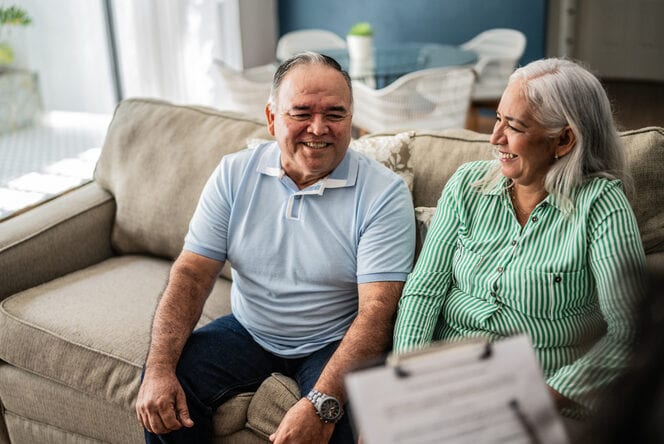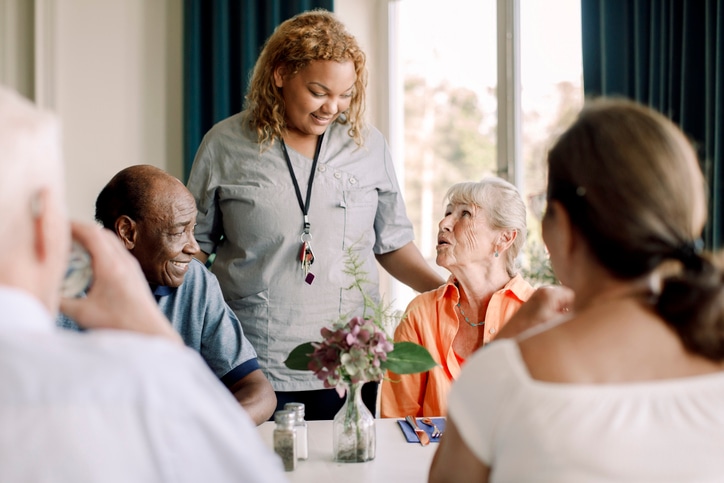In this article
As we age, assisted living can be a great way to get help with the activities of daily living while also maintaining some privacy and independence. But making this move when you’re married or in a long-term relationship can be more complicated. You might wonder if there’s even such a thing as assisted living for couples (there is!) and how to balance the needs of each person in your relationship.
“Couples often worry about whether they’ll still have privacy, how their different care needs will be handled or if the move will disrupt their relationship,” says Moti Gamburd, CEO of Raya’s Paradise, a residential senior care community that offers assisted living, memory care, hospice care and respite services.
There are also often concerns about cost and what will happen if the medical needs of one or both people in the couple change over time. Here, we’ll take a close look at assisted living for couples, along with expert insights and advice.
Key takeaways
- Most assisted living facilities can accommodate couples who want to stay together.
- Assisted living options for couples include larger units to accommodate two people or separate units in the same assisted living facility.
- It’s important to choose a community that can accommodate your needs now, as well as your changing needs in the future.
Assisted living for elderly couples
“Couples can absolutely live together in assisted living, and this is becoming more common,” Gamburd says. “Many assisted living communities offer shared accommodations where couples can stay together while receiving care fit to their needs.”
There are even options for assisted living for couples with different needs. “Couples can have individualized service plans, but both are able to receive care from the same group of staff,” says Natasha Killian, certified social worker and resident services director at Capitol Lakes Retirement Community. “Care needs are often unpredictable, so having that onsite support offers a great layer of security.”
Though every assisted living community is different, common couple accommodations include:
- Larger rooms and suites. “Larger rooms and suites are becoming higher in demand so couples can share a living space more comfortably,” Killian says. Of course, the size and type of room or suite you have depends on availability and finances.
- Separate units in the same community. Sometimes the medical needs of one person in the couple is greater than the other. “It’s not uncommon for couples to move into the same assisted living facility, but have separate studio-style units,” says Killian. Not only does this ensure the person with greater needs stays safe, but it protects the caregiving spouse from sacrificing their own health to care for their loved one.
How much does assisted living cost for a couple?
The average cost of assisted living for a couple typically ranges between $4,500 and $10,000 a month, according to Gamburd. The national average cost of a solo room at an assisted living facility is estimated to be about $5,900 per month, per the most recent Cost of Care survey by Genworth. For couples rooming together, there would likely be a single monthly room fee, plus an additional charge for the second person.
“Many communities guide families through the financial aspects and help identify resources like veterans’ benefits or long-term care insurance to make the transition easier.”
— Moti Gamburd, senior living expert
The cost of assisted living for couples can vary widely, especially from one geographical location to another and depending on care needs. Factors that can impact cost include:
- The size of the unit.
- How many units are needed.
- The level of support needed for each person.
- Included amenities.
- Location.
Shared rooms or apartments usually cost less than separate accommodations, Gamburd says. Additionally, if one partner needs specialized care, such as memory support, the cost would increase even more.
“Many communities guide families through the financial aspects and help identify resources like veterans’ benefits or long-term care insurance to make the transition easier,” Gamburd says. Medicare, Medicaid and some insurance policies will also help cover the cost of assisted living, but there are caveats, depending on which policy you have.
Other senior living options for elderly couples
While assisted living is a great option for many couples, here are some senior living alternatives that may also suit your needs.
Continuing Care Retirement Communities
Continuing Care Retirement Communities (CCRCs) are facilities that offer varying levels of care and are able to accommodate changing needs as time goes on. This means that if your care needs become more complex or you need additional services, the facility can adapt so that you don’t have to relocate.
Killian says CCRCs are a strong choice for couples. “Couples often start with making a move to the independent living portion of a CCRC as a stepping stone to living in a more secure environment,” she explains. “Then, each can move through the continuum of care as their needs become greater.”
Home care
Assisted living isn’t the only option for when you need help with the activities of daily living. This same care can also be offered in the comfort of your own home. Home care “is especially a good option when a recommendation for 24/7 care has not been made,” says Killian. “Even when both spouses require some care, a more limited but regular schedule with a caregiver is often all that is needed.”
Separate living arrangements
Although assisted living for couples with differing needs can usually work — such as by living separately but in the same facility — sometimes assisted living for a couple just isn’t in the cards. “Health issues, like one partner needing intensive medical care, can make shared living impractical,” says Gamburd. “In other cases, the couple might have different preferences or simply disagree about the move.”
If living together doesn’t look like it will be a reality for you or your loved ones, you might want to consider alternatives, such as one person entering assisted living while the other lives nearby — either alone or with in-home care. “I’ve seen families get creative, like arranging daily visits or video calls to maintain connection,” Gamburd shares.
“The first thing to think about is how both of your needs can be met, both now and in the future.”
— Moti Gamburd
How to choose the right assisted living for couples
Perhaps the biggest challenge of assisted living for couples is managing their different needs, as well as the fact that people’s needs often change over time. Sometimes these changes can happen gradually, but sometimes needs change rapidly, such as when someone has a bad fall or a new, serious medical diagnosis.
It’s important to make sure that whatever assisted living community you and your partner enter will be able to accommodate these changing needs, and will do so while honoring your relationship. “The first thing to think about is how both of your needs can be met, both now and in the future,” says Gamburd.
He suggests asking prospective assisted living facilities questions like:
- What happens if one person’s care needs increase?
- How does the community adapt to one person’s changing needs?
- What living options will be available for each member of the couple?
- What happens if one person needs different accommodations?
- Do you have experience supporting couples?
Consider picking assisted living that offers extra services, like memory care or access to nursing care, as these are services that may be required when care needs become more intense, Killan says. “It’s advantageous for an individual to stay on familiar grounds as their needs increase, even if it means moving to a different floor or building. It also makes it easier on the spouse for visiting purposes.”
Where to find support as you consider assisted living
Navigating the questions surrounding assisted living for couples can be tricky. Thankfully, most facilities are familiar with these concerns and can help meet the varying needs of each couple.
Additionally, discussing your care needs with your doctor or a professional geriatric care manager can help you understand better what you may need in the years to come, and what the best options are for you and your spouse. “The key is to communicate and prioritize what works best for both partners,” Gamburd concludes.





